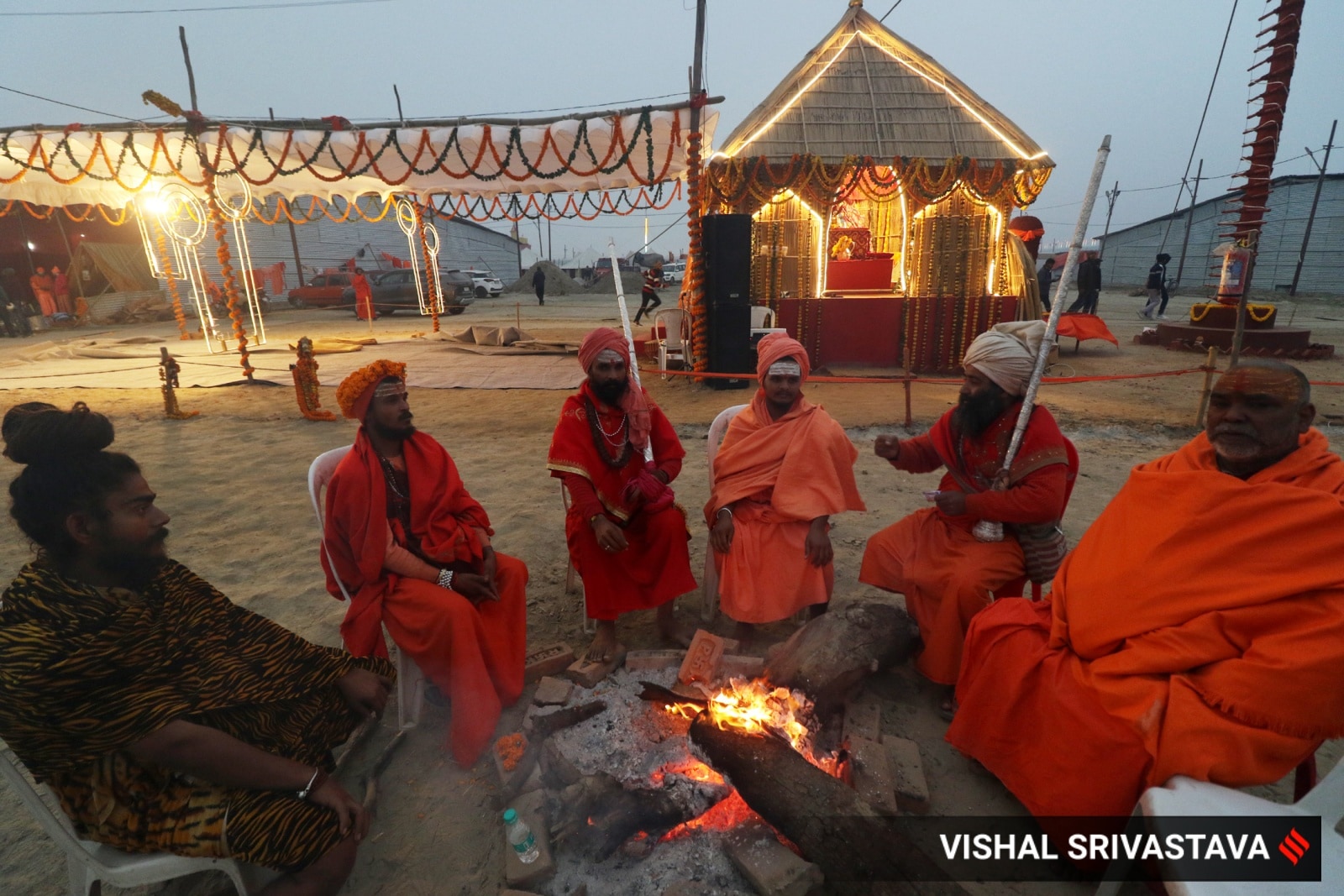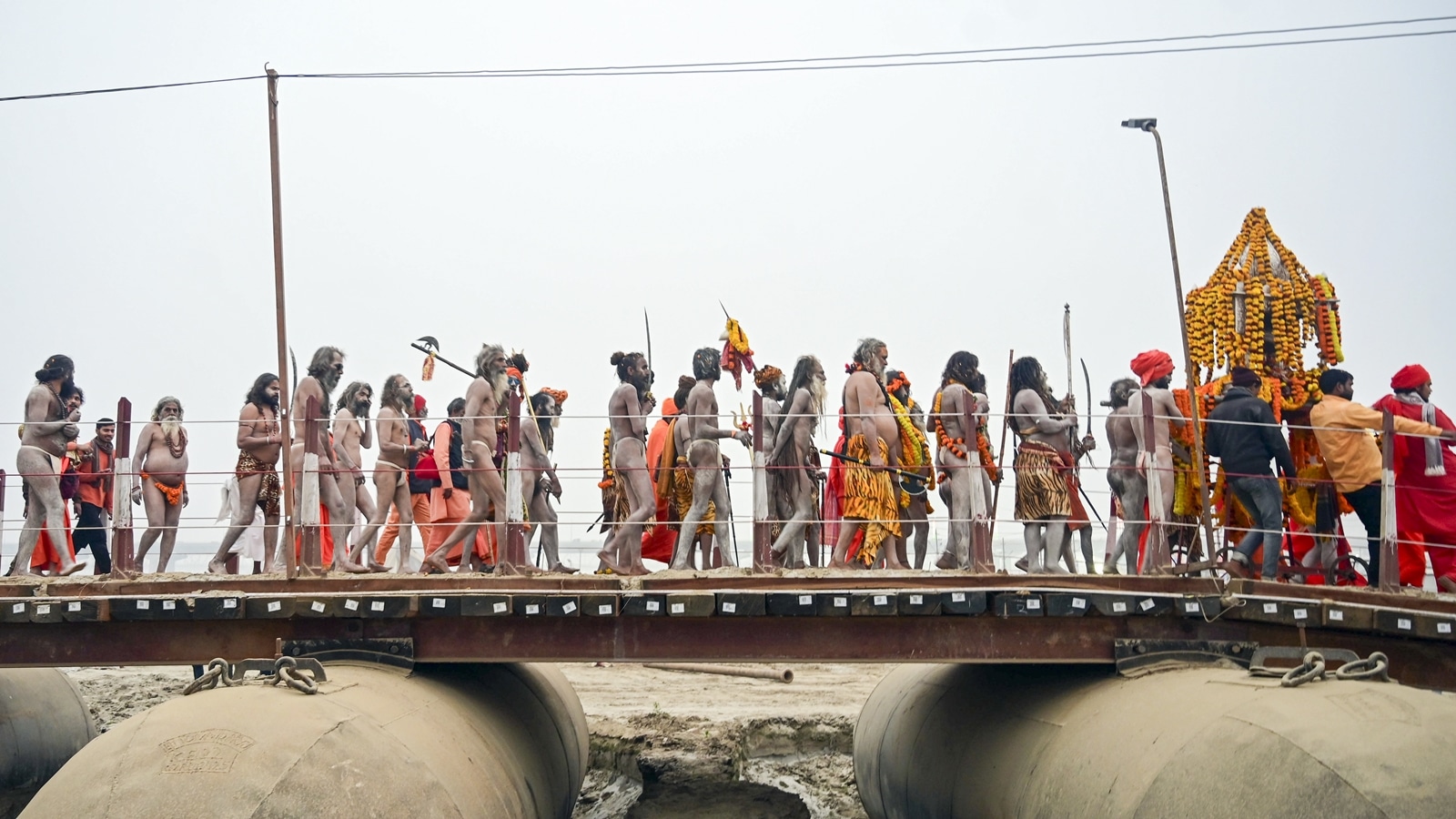Vijaypuri Bapu, a naga sadhu, has nothing to his name except his smartphone. Residing in a small hut on the Maha Kumbh mela grounds in Prayagraj, he has been grappling with Internet connectivity. “I have been playing bhajans (hymns) and taking photos on my phone. Since there is no Internet, I cannot use any of the Kumbh apps,” he says.
This year, the Uttar Pradesh government has made a huge technological push with its Digi Kumbh initiative. The sprawling mela ground is now underpinned by a robust digital infrastructure, a web of surveillance systems powered by artificial intelligence (AI), and an intricate network of tools designed to monitor, protect and serve.

Surveillance has been elevated to unprecedented levels this time, say officials. The mela’s Integrated Command and Control Centre is the brain of the entire operation, where officials sit behind high-end computing systems that give them a bird’s eye view of the ground. To facilitate real-time monitoring, four 52-seater viewing centres have been established.
Monitored by over 2,750 CCTV cameras bolstered by AI to track the movement of the anticipated 40 crore pilgrims, this Kumbh will be the largest face recognition exercise in the country thus far.
 Sadhus who come to the Maha Kumbh sit around bonfires, trying to protect themselves from the heavy cold waves at the banks of the Sangam in Prayagraj. (Express Photo by Vishal Srivastav)
Sadhus who come to the Maha Kumbh sit around bonfires, trying to protect themselves from the heavy cold waves at the banks of the Sangam in Prayagraj. (Express Photo by Vishal Srivastav)
Officials say 108 cameras are dedicated to number plate recognition, while 268 AI-powered video analytic cameras will monitor crowd movement. Additionally, 240 AI-based video analytics systems will count vehicles, ensuring efficient traffic flow and parking management, officials add.
Allaying fears regarding the misuse of surveillance systems, mela officer Vijay Kiran Anand tells The Indian Express, “We have released tenders for Indian companies. Their servers are based in the country. This ensures we have control over the data and a third party based in another country doesn’t access that information.”
On the accuracy of AI models, officer Anand says, “We have been employing machine learning techniques since last year. The model’s accuracy is improving on a daily basis.”
Story continues below this ad
However, the AI system may still face challenges. A senior official says there may be “overlapping features” due to high crowd density, “making it difficult for AI algorithms to differentiate individuals”.
The officer adds, “A lot also depends on the quality of cameras. Environmental factors like poor lighting and weather conditions can degrade image quality. Unpredictable movements in large crowds may hamper identification. The sheer scale of the gathering demands massive computational power for real-time data processing.”
 Sadhus of Shri Taponidhi Anand Akhara Panchayati take part in the ‘Peshwai’ procession, in Prayagraj on Monday. (PTI/File)
Sadhus of Shri Taponidhi Anand Akhara Panchayati take part in the ‘Peshwai’ procession, in Prayagraj on Monday. (PTI/File)
At the Parade Ground police lines area, officers use QR codes to join WhatsApp groups for mela work. Beyond that token nod to technology, their operations rely heavily on old-school walkie-talkies and sporadic smartphone communication.
At the cyber police station, housed in a makeshift tin shed draped in the force’s shades of red and blue, a team of officers is busy tracing lost mobile phones. Of the 25 thefts reported so far, only five phones have been recovered.
Story continues below this ad
This is the first time a cyber team has been deployed at the Kumbh. The 14-member team is tasked with both surveillance and resolving cybercrime. A senior officer at the cyber police station says, “These are temporary police stations. Once the mela ends, we will leave for our districts and the cases will be taken over by the commissionerate. We will do our best to solve cases till then.”
Officials say cases of cyber fraud are mounting, with reports of people being duped in the name of the tent city. Fraudsters have lured victims into transferring money to fake bank accounts, with even senior officials falling prey to such scams.
“Awareness campaigns don’t seem to be working. We have made an arrest in an extortion case, but cyber frauds are increasing. We have come across over eight cases so far. If people from Gurgaon are getting duped, how effective are these programmes really?” says the officer.
 Sadhus of ‘Shree Mahanirvani Akhada’ take part in the ‘Chavni Pravesh’, the royal entry procession for Maha Kumbh. (PTI/File)
Sadhus of ‘Shree Mahanirvani Akhada’ take part in the ‘Chavni Pravesh’, the royal entry procession for Maha Kumbh. (PTI/File)
For the first time, the UP police have deployed underwater drones equipped with advanced imaging capabilities to patrol the riverbed. These drones, alongside remote-controlled life buoys, provide 24/7 aquatic surveillance, transmitting real-time data to the command centre.
Story continues below this ad
Apart from AI surveillance systems, the government has also launched its own AI-powered chat-bot, which supports over 11 languages and is integrated with Google Maps to help with navigation.
At the heart of this digital transformation is a determination to ensure that the vast logistical machinery of the Kumbh remains accountable.
The authorities have divided the ground into 10 zones and 25 sectors, each mapped using Geographic Information Systems (GIS) integrated with Google Maps.
To streamline the event, the government has also deployed an automated ration supply system and drone-based monitoring for disaster management. “Additionally, a real-time software will track the progress of 530 projects, while an inventory tracking system and integration of all sites on Google Maps will provide detailed navigation,” the official says.
Story continues below this ad
 Prefabricated toilets being set up for the Maha Kumbh in Prayagraj. (Express Photo by Vishal Srivastav)
Prefabricated toilets being set up for the Maha Kumbh in Prayagraj. (Express Photo by Vishal Srivastav)
Over 37,000 police personnel have been deployed, including 1,378 women officers, supported by specialised cyber experts and intelligence squads. Articulating water towers have been put on standby in case of fires. These towers, equipped with thermal imaging, can reach heights of up to 35 metres, offering a protective shield for fire-fighters in high-risk situations, officials say.
A GIS-based map has been utilised to design the mela’s layout. “We had undertaken drone surveys to create precise topographical maps of the land. We used the 2019 Kumbh data to make a better resource allocation plan,” says a government official.
Meanwhile, at the Prayagraj Mela Authority campus, the problems of applicants who applied for land allotments online came to the fore, with multiple organisations alleging their land remains to be allocated despite the mela starting on January 13. At least 15,000 people from three states claim that land is yet to be allotted to them.
 Langars organized by the different Akharas for people attending the Maha Kumbh in Prayagraj. (Express Photo by Vishal Srivastav)
Langars organized by the different Akharas for people attending the Maha Kumbh in Prayagraj. (Express Photo by Vishal Srivastav)
Rajesh Kumar Sharma, general secretary, Nai Sudhar Samiti, Prayagraj, is flanked by over a dozen people arguing with a UP police officer, who patiently jots down all complaints.
Story continues below this ad
“We have been freezing on the river bank. There is no place for us to stay. We booked our allotments online, but when we arrived here, we learnt that some other party had objected to the allocation. Now, we are stuck,” says a complainant.
Showing his online allotment slip, Subhash, president, Kirti Seva Sansthan, begs the officials for land allocation. “We were allotted land online, but now officials tell us there is no space. We didn’t face this issue when we had applied for this allocation in person last time,” he says.



 Sadhus who come to the Maha Kumbh sit around bonfires, trying to protect themselves from the heavy cold waves at the banks of the Sangam in Prayagraj. (Express Photo by Vishal Srivastav)
Sadhus who come to the Maha Kumbh sit around bonfires, trying to protect themselves from the heavy cold waves at the banks of the Sangam in Prayagraj. (Express Photo by Vishal Srivastav) Sadhus of Shri Taponidhi Anand Akhara Panchayati take part in the ‘Peshwai’ procession, in Prayagraj on Monday. (PTI/File)
Sadhus of Shri Taponidhi Anand Akhara Panchayati take part in the ‘Peshwai’ procession, in Prayagraj on Monday. (PTI/File) Sadhus of ‘Shree Mahanirvani Akhada’ take part in the ‘Chavni Pravesh’, the royal entry procession for Maha Kumbh. (PTI/File)
Sadhus of ‘Shree Mahanirvani Akhada’ take part in the ‘Chavni Pravesh’, the royal entry procession for Maha Kumbh. (PTI/File) Prefabricated toilets being set up for the Maha Kumbh in Prayagraj. (Express Photo by Vishal Srivastav)
Prefabricated toilets being set up for the Maha Kumbh in Prayagraj. (Express Photo by Vishal Srivastav) Langars organized by the different Akharas for people attending the Maha Kumbh in Prayagraj. (Express Photo by Vishal Srivastav)
Langars organized by the different Akharas for people attending the Maha Kumbh in Prayagraj. (Express Photo by Vishal Srivastav)





























